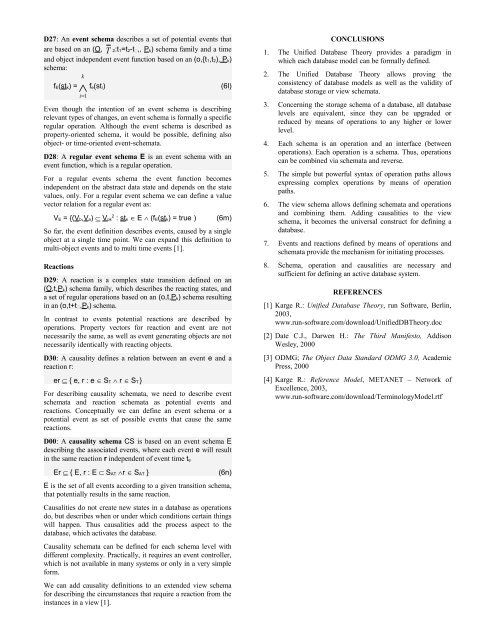Unified Database Theory - ODBMS
Unified Database Theory - ODBMS
Unified Database Theory - ODBMS
You also want an ePaper? Increase the reach of your titles
YUMPU automatically turns print PDFs into web optimized ePapers that Google loves.
D27: An event schema describes a set of potential events that<br />
are based on an (O, T 2:t1=t2-t,, Pk) schema family and a time<br />
and object independent event function based on an (o,{t1,t2), Pk)<br />
schema:<br />
k<br />
fE(stk) = fe(sti) (6l)<br />
i1 Even though the intention of an event schema is describing<br />
relevant types of changes, an event schema is formally a specific<br />
regular operation. Although the event schema is described as<br />
property-oriented schema, it would be possible, defining also<br />
object- or time-oriented event-schemata.<br />
D28: A regular event schema E is an event schema with an<br />
event function, which is a regular operation.<br />
For a regular events schema the event function becomes<br />
independent on the abstract data state and depends on the state<br />
values, only. For a regular event schema we can define a value<br />
vector relation for a regular event as:<br />
VE = {(Vb,Va) Vpk 2 : stk E (fE(stk) = true ) (6m)<br />
So far, the event definition describes events, caused by a single<br />
object at a single time point. We can expand this definition to<br />
multi-object events and to multi time events [1].<br />
Reactions<br />
D29: A reaction is a complex state transition defined on an<br />
(O,t,Pk) schema family, which describes the reacting states, and<br />
a set of regular operations based on an (o,t,Pk) schema resulting<br />
in an (o,t+t,Pk) schema.<br />
In contrast to events potential reactions are described by<br />
operations. Property vectors for reaction and event are not<br />
necessarily the same, as well as event generating objects are not<br />
necessarily identically with reacting objects.<br />
D30: A causality defines a relation between an event e and a<br />
reaction r:<br />
er { e, r : e ST r ST }<br />
For describing causality schemata, we need to describe event<br />
schemata and reaction schemata as potential events and<br />
reactions. Conceptually we can define an event schema or a<br />
potential event as set of possible events that cause the same<br />
reactions.<br />
D00: A causality schema CS is based on an event schema E<br />
describing the associated events, where each event e will result<br />
in the same reaction r independent of event time te<br />
Er { E, r : E SAT r SAT } (6n)<br />
E is the set of all events according to a given transition schema,<br />
that potentially results in the same reaction.<br />
Causalities do not create new states in a database as operations<br />
do, but describes when or under which conditions certain things<br />
will happen. Thus causalities add the process aspect to the<br />
database, which activates the database.<br />
Causality schemata can be defined for each schema level with<br />
different complexity. Practically, it requires an event controller,<br />
which is not available in many systems or only in a very simple<br />
form.<br />
We can add causality definitions to an extended view schema<br />
for describing the circumstances that require a reaction from the<br />
instances in a view [1].<br />
CONCLUSIONS<br />
1. The <strong>Unified</strong> <strong>Database</strong> <strong>Theory</strong> provides a paradigm in<br />
which each database model can be formally defined.<br />
2. The <strong>Unified</strong> <strong>Database</strong> <strong>Theory</strong> allows proving the<br />
consistency of database models as well as the validity of<br />
database storage or view schemata.<br />
3. Concerning the storage schema of a database, all database<br />
levels are equivalent, since they can be upgraded or<br />
reduced by means of operations to any higher or lower<br />
level.<br />
4. Each schema is an operation and an interface (between<br />
operations). Each operation is a schema. Thus, operations<br />
can be combined via schemata and reverse.<br />
5. The simple but powerful syntax of operation paths allows<br />
expressing complex operations by means of operation<br />
paths.<br />
6. The view schema allows defining schemata and operations<br />
and combining them. Adding causalities to the view<br />
schema, it becomes the universal construct for defining a<br />
database.<br />
7. Events and reactions defined by means of operations and<br />
schemata provide the mechanism for initiating processes.<br />
8. Schema, operation and causalities are necessary and<br />
sufficient for defining an active database system.<br />
REFERENCES<br />
[1] Karge R.: <strong>Unified</strong> <strong>Database</strong> <strong>Theory</strong>, run Software, Berlin,<br />
2003,<br />
www.run-software.com/download/<strong>Unified</strong>DB<strong>Theory</strong>.doc<br />
[2] Date C.J., Darwen H.: The Third Manifesto, Addison<br />
Wesley, 2000<br />
[3] ODMG; The Object Data Standard ODMG 3.0, Academic<br />
Press, 2000<br />
[4] Karge R.: Reference Model, METANET – Network of<br />
Excellence, 2003,<br />
www.run-software.com/download/TerminologyModel.rtf


